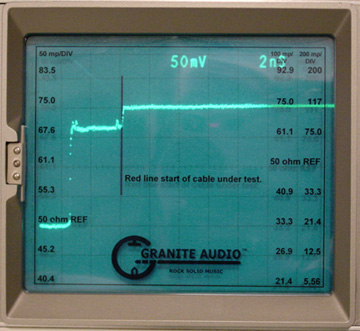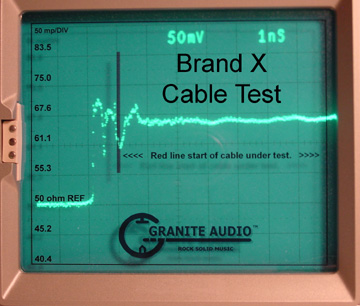 |
 |
 |
 |
 |
 |
 |
 |
 |
 |
 |
 |
 |
 |
 |
 |
 |
 |
 |
 |
|
|
|
|
|
|
|
|
|
|
|
|
|
|
|
|
|
|
|
|
|
 |
|
|
|
|
|
|
|
GRANITE AUDIO is a system concept.
A system with true synergy.
|
|
|
|
|
|
|
|
|
|
 |
|
|
|
|
|
|
|
|
|
Model 420 Interconnect Cable
For Digital or Analog Video and Digital Audio.
|
|
|
|
|
|
|
|
|
|
|
|
|
 |
|
|
|
|
|
|
|
|
|
|
|
|
|
|
|
MODEL #420 INTERCONNECT
FOR VIDEO & DIGITAL-AUDIO
3.01 GHz Bandwidth
This ultra-high-performance Micro-75 series cable has both 100% Bonded Foil and 96% Braid Shielding for the ultimate in crystal-clear performance, even in the longer lengths required in modern custom home theater systems.
The #420 meets SMPTE 292M Broadcast Digital Standards (SDI) and delivers 1.51Gb/s HDTV brilliant quality signals up to 215 feet, and has an Extended Bandwidth of 3.01GHz. The characteristic impedance is 75 ohms, +1.6 ohms, and this new AV cable is available with one-piece 75 ohm RCA, BNC, or F connectors with an impressive High Return Loss of >34dB @ 1.2GHz.
The #420 is engineered to deliver all the high-resolution picture and sound quality of your original DVD, D-VHS, HD Receiver, or CD source with full rich signal response and the blackest possible background.
|
|
|
|
|
|
|
|
|
|
|
|
|
|
|
|
|
 |
|
|
|
|
|

|
|
|
|
|
|
|
|
|
|
|
A CUSTOMER REVIEW OF THE #420 CABLE.
Gentlemen, It has been several weeks now since the arrival of my new digital cables from Granite Audio and, as I felt that was sufficient break-in time, I wanted to post a few of my thoughts with regards to the #420.
I bought two of the #420 cables, one to feed from a Pioneer Elite DVD player into my processor and the other to audition between my Metronome transport and my Modwright MSB Platinum Plus DAC. This latter pairing was a bit of a lark as the XLR digital input of the DAC has been modified in a fashion which the RCA connection has not. But I wanted to try it out as I had high expectations, knowing the type of cables Granite produces otherwise.
The first swap was at the Pioneer set up. I have read reviews where the individual writes that a "veil was removed from the sound". Such was not the case here. I would describe the difference as more of removing a blanket. I didn't realize that the original cable was so dark until listening to your new #420. Keep in mind that this other cable was no slouch in its own right
and had earned the right to be in my system. True, while I had always been impressed with the sound from this Elite unit on movies, it was somewhat less than what I wanted for music. No longer is that the case. I can honestly tell you that this cable made a bigger difference in my system than many of the mods I have had performed in the past. In effect, your digital cable took a mid-priced, mid-fi unit and managed to elevate it to a level of performance attained previously by modifications costing two to three times as much and taking weeks to implement. A better piece of equipment from a simple 5 minute change of a cable? Amazing! But the more interesting test was to be an unfair one, I felt. My reference 2 channel set up is tough to beat and one that I am very proud of. The Metronome is a constant and the Modwright MSB is a wonder. I had hoped the
RCA connection with your Granite 420 would sound good, but I never thought it might best the modified XLR input. I will tell you it was both surprising and difficult to judge. Surprising because it should have been a hands down, XLR all-the-way show. Difficult because they were so close it took hours and hours to decide. In the end, I removed the balanced cable and kept the RCA connected Granite digital cable!
The soundstage was similar with both cables, both being very wide and impressive. But the voices were more distinct on the Granite cable. I found the sound to be very lively, yet not brittle at all. On some tracks, I felt the XLR input was slightly more articulate sounding on strings, but I attribute the difference to the modifications on the balanced side and not to the other XLR cable itself. It is my opinion that a balanced version of your #420 cable would be even better than this RCA version and, in my system, be the utmost in digital cabling. For your information, the XLR cable that you replaced was a high end, 99.99 % silver cable with some top-of-the-line connectors.
Thank you for your research and efforts on this cable, I know you have been working on this for over a year with several people pressuring you into getting to market, as it were. I can assure you that it has been worthwhile. I look forward to more of this cable making the publications and to hearing what some other more well regarded reviewers might have to say.
By Walter S.
|
|
|
|
|
|
|
|
|
 |
|
|
|
|
|
|
|
|
Photo showing Micro-75 cable under test on a $35,000.00 Tektronix
TDR Time Domain Reflectometer.
Note the nice flat trace
on the 75 ohm line.
Click this link to
view a larger photo
of the TDR screen.
|
|
|
|
|
|

|
|
|
|
|
|
|
|
 |
|
|
|
|
|
|
|
|
Photo showing Brand X
cable under test.
Note the wavy line that is no where near the 75 ohm line. This cable will have extreme reflections and signal loss. Also note how jagged the line is between the 50 ohm Reference Line and the start of the cable under test. This is a good example of Reflections. This section of the trace is jagged because of all the reflections coming backwards from the cable under test being no where near 75 ohm impedance. These Reflections also reflect forward into the next component.
You will note the Micro-75 cable does not have these reflections and this part of the trace is much smoother on the Micro-75 cable.
|
|
|
|
|
|

|
|
|
|
|
|
|
|
 |
|
|
|
|
|
|
|
TRUE 75 OHM CHARACTERISTIC IMPEDANCE.
Each finished Micro-75 cable is tested, from tip-to-tip including the terminations, on a $35,000.00 Tektronix TDR Time Domain Reflectometer with an 11 GHz pulse and certified to a bandwidth of 3.01 GHz. Then a photo is taken of the TDR screen showing the cable under test, and printed out, and shipped with the cable to show that the cable is truly 75 ohms from tip-to-tip including the terminations. The photo will also show the cable's serial number, model number, length, date of test, and the testing engineer's signature. And this is all done in-house at the Granite Audio Factory to insure the best possible quality control of this world renowned video-digital cable.
The photo above shows a Micro-75 cable under test. The cable is being tested at 50mv at 2 nanoseconds and you can see this info on the screen. At the left of the screen you will see the impedance lines. The line marked "50 ohm REF" is the part of the test loop that consists of the Precision 50 ohm cable built into the TDR. The cable under test is compared by the TDR to this Reference cable. Then the portion of the signal trace that is between the 50 ohm reference cable and the cable under test is a jagged line that represents the cable adapters to mate the TDR's special pulse head connectors to the RCA, BNC, or F connectors of the Micro-75 cable. The trace for the cable under test begins at the bold vertical line and goes to the right side of the photo. A quality 75 ohm cable will have this portion of the trace exactly centered on the 75 ohm line and be very flat within +- 1.6 ohms for the entire length of the cable including the tips.
If there are any flaws in the cable or if the manufacturer uses cheap 50 ohm connectors, there will be a peak or a dip in the signal trace. In the case of a cheap 50 ohm connector, the first part of the trace will start on the 50 ohm impedance line for the length of the connector, then climb up to the 75 ohm line where the trace is representing the cable. And this variation
in impedance from true 75 ohms will cause reflections or echoes in the cable. Each deviation will cause reflections and the reflections are added to previous reflections. If you have enough reflections and enough serious deviations, your signal will be seriously compromised and can even be lost completely.
Part of the great performance of the Micro-75 digital cables is their exact tolerance to a true 75 ohm characteristic impedance. This means the entire signal is cleanly passed through the entire cable length with the absolute minimum of reflections and echoes. Then add in the superior double shielding, quality one-piece construction RCA plugs, quality hand termination, and mil-spec heat shrink; and you simply have the best digital cable on the planet.
|
|
|
|
|
|
|
|
|
 |
|
|
|
|
|
|
|
Granite Audio - Vacuum tube amps, preamps, speaker cables, AC power cords, CD players, granite speakers, amplifiers, tubes, silver interconnect cables, stereo.
|





